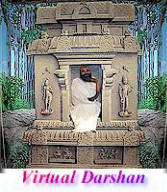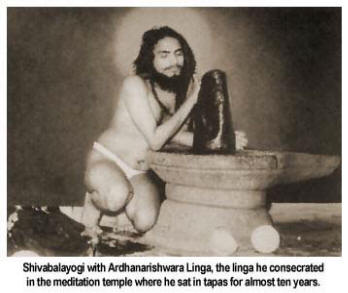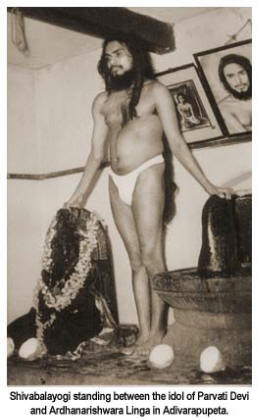|
|
|
The place where tapas has been done is sacred. The divine power attained through spiritual penance remains concentrated in that place, always available to transform the visitor who seeks its blessings. Within a few months after Shivabalayogi completed tapas, his devotees asked him to commemorate the place where he sat in tapas by installing the permanent presence of his divine guru, Lord Shiva and Goddess Parvati. Shri Swamiji agreed, and shortly thereafter he had a vision of a beautiful naturally formed (svayambhu) Shiva linga in his meditation. It was revealed to him that this was the linga to be installed in the meditation temple and that it could be found in the Narmada River near the Omkareshwara temple. This temple is famous because only at this one area in this one river can a particular type of very dense stone be found which is revered as naturally formed lingas sacred to Lord Shiva. A devotee named Narayan Das set off for Omkareshwara and sat in meditation at the place Swamiji had indicated. He meditated for twenty days, but no vision came and he became increasingly dejected. His failure pressed on his mind as he stared at the river dejectedly. As he stared, his mind became calm and he went into a deep meditation. Suddenly he had a vision of light coming from within him and illuminating the area around him. He opened his eyes and saw that the brilliant light was actually coming from his forehead and was directed to a point in the middle of the river. There he saw the light glistening on a beautiful Shiva linga jutting out of the water, reflecting back brilliant hues of silver and gold. Narayan Das excitedly waded into the river and retrieved the linga which Shri Swamiji had seen in meditation.
While the search for the linga was going on, a specially commissioned statue of Parvati Devi was being sculpted in Bangalore. The installation of this statue took place immediately after the consecration of the linga, in early 1963, shortly before Mahashivaratri. Swamiji named the linga Ardhanarishwara. Swamiji would tell devotees that Ardhanarishwara Linga is a linga of light (jyoti linga), among the most revered lingas in the world. On other occasions, Swamiji indicated that Ardhanarishwara Linga was the atmalinga, Lord Shiva’s actual soul, the same Atmalinga that Ravana Asura obtained from Shiva. |
 |
|
His Life |
| birth |
| childhood |
| childhood stories |
| enlightenment |
| beginning tapas |
| early obstacles |
| four directions |
| tapas completion |
| Adivarapupeta |
|
Ardhanarishwara Linga & Devi |
| India travels |
|
Banagalore ashram temple |
| Adivarapupeta ashram |
| in the West |
| mahasamadhi |
|
|
| yogi |
| religions |
| spiritual leaders |
| Jesus & Buddha |
| God |
| forms of God |
| guru-devotee |
| Swamiji's mission |
| initiation, vibhuti |
| meditation |
| samadhi (enlightenment) |
| tapas & Self realization |
| bhajans(devotional song) |
|
bhava samadhi (spiritual trance) |
| world conditions |
| foundation |
| Swamiji's words |
| Virtual Darshan |
|
|
|
Shri Shivabalayogi Maharaj
International Trust P.O. Box 293 Langley, WA 98260 U.S.A. info@Shiva.Org |
 God
has no form, is everywhere and is no “where”. Yet Swamiji explained that the
divine presence is anchored in sacred images and places. A linga is a stone,
generally with a round and slightly long shape, that is a form of Shiva, the
God who ultimately is the Soul within each being.
God
has no form, is everywhere and is no “where”. Yet Swamiji explained that the
divine presence is anchored in sacred images and places. A linga is a stone,
generally with a round and slightly long shape, that is a form of Shiva, the
God who ultimately is the Soul within each being. The
linga was brought to Adivarapupeta and put under Swamiji’s dais. The linga
is of heavy and very dense stone, but a reasonably strong person should have
been able to lift it off the ground. Before it was installed, Swamiji played
games and asked some of the devotees if they could lift it. Several men
would try, confident in their physical strength, and were unable. Then
Swamiji would ask a lady or even a small child who had no difficulty picking
up the great stone. Swamiji said that if there is devotion in the heart,
even a child can move Lord Shiva in this stone form. “This linga is
going to surrender to those who have devotion, not with those who have
power. Not with shakti [force] but bhakti [devotion].”
The
linga was brought to Adivarapupeta and put under Swamiji’s dais. The linga
is of heavy and very dense stone, but a reasonably strong person should have
been able to lift it off the ground. Before it was installed, Swamiji played
games and asked some of the devotees if they could lift it. Several men
would try, confident in their physical strength, and were unable. Then
Swamiji would ask a lady or even a small child who had no difficulty picking
up the great stone. Swamiji said that if there is devotion in the heart,
even a child can move Lord Shiva in this stone form. “This linga is
going to surrender to those who have devotion, not with those who have
power. Not with shakti [force] but bhakti [devotion].”